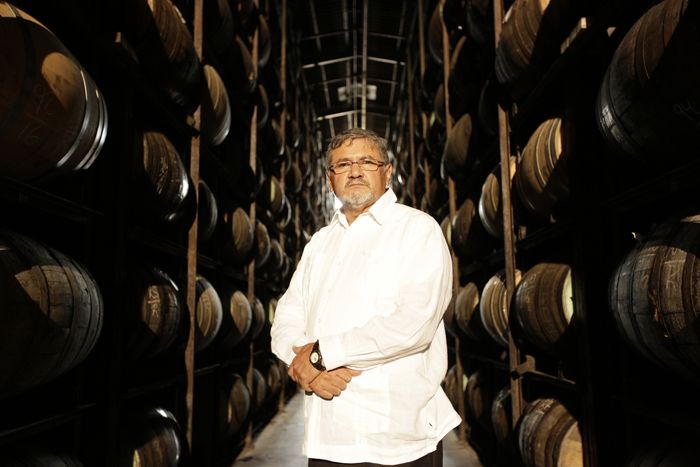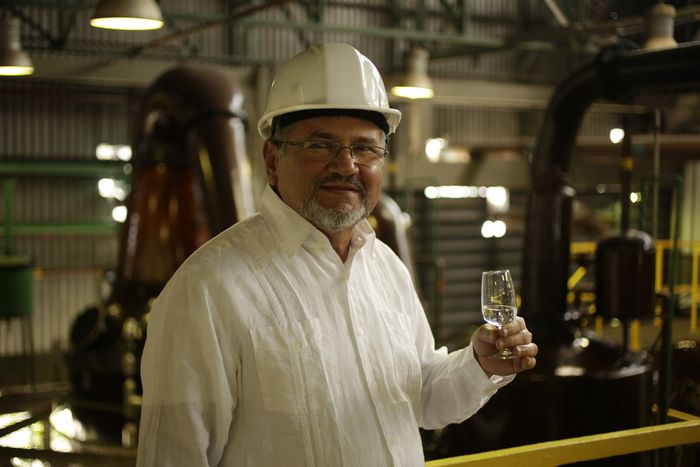
Diplomatico has been the driving force behind rum for the past decade, and is often at the center of debates about what constitutes rum. The brand champions a relatively recent tradition of sweet, mild rums that are simplistically associated with the Hispanic style.
However, for some time now, Diplomatico has also been listening to increasingly demanding enthusiasts, particularly in terms of transparency.
After offering a few non-sweet expressions, she is also more willing to talk about her manufacturing processes.
We wanted to find out more with Nelson Hernandez , the house's maestro ronero .
Dear Nelson, thank you for accepting this interview, can you introduce yourself?
My name is Nelson Hernández, a mechanical engineer graduated 40 years ago, and one of the “maestros roneros” of Diplomatico rums. I have been working in our distillery for almost 34 years, with heart and passion.
How did the “Diplomatico” way of making rum come about?
This way of doing things was born in the very beginnings of our distillery, when it was founded in 1959 by Seagram International LTD. This company had 100 years of experience in the alcohol industry, with a style focused on quality and innovation, and this at all stages and activities of the production process. These values are part of our heritage and our working style.
How would you define the identity of Diplomatico rums?
Diplomatico rums are carefully crafted and are unique due to the intricacies of the distillation process. They are distilled using a variety of methods, including various continuous columns ( the Hispanic rum tradition ), old pot stills ( the British whisky tradition ), and a unique batch kettle system ( the American whisky tradition ). In addition, the use of different casks, the terroir, the climatic conditions and the expertise of the cellar masters all contribute to defining the identity of Diplomatico rums.
What are the requirements of the “ Ron de Venezuela ” DOC? (DOC: Denominacion de Origen Controlada)
– Comply with Venezuelan legal regulations
– Comply with the quality standard
– 100% made in Venezuela with honey or sugar cane molasses produced in defined geographical areas
– Minimum aging of 2 years in American oak barrels
– Alcohol content between 40% and 50%
Can you describe the raw materials of Diplomatico rums, and in particular the difference between cane honey and molasses? (it seems that the definition of “cane honey” is different from one country to another)
All the sugarcane produced in Venezuela goes to the sugar factories. During the process of obtaining the sugar crystals, two fluids with different sugar concentrations are produced. The first fluid, obtained during the first sugar extraction, is called cane honey and its sugar content is between 55% and 65%. The second fluid obtained during the second sugar extraction is called molasses, and its sugar content is between 45% and 55%.
In some countries, the fluid obtained after the process of evaporation of water from cane juice is called virgin cane honey, it is then subjected to the sugar extraction process.
Do you practice different types of fermentation at the distillery?
There is only one type of fermentation, alcoholic fermentation, but it can take place under two different atmospheric conditions. Molasses is fermented for 24 hours, and cane honey for 48 hours.
What distillation equipment do you use?
We are equipped with continuous distillation apparatus and discontinuous distillation apparatus, built from 100% copper.
What are the congener levels of each rum you produce?
(the congeners are the aromatic compounds, expressed here in grams per hectoliter of pure alcohol, editor's note)
– Light: less than 100 g / hlAP
– Semi-complex: between 100 g and 200 g / hlAP
– Complexes: more than 300 g / hlAP
Do you blend these different types of rum before or after aging?
We assemble them after aging.
Can you tell us the proportions and ages that go into the blends in the Diplomatico range?
Planas : 50% heavy (complex) rums that are up to 6 years old, and 50% of other styles (light and semi-complex) aged 4 to 6 years.
Mantuano : 40% heavy rums that are up to 8 years old, and 60% of other styles (light and semi-complex) aged 4 to 6 years.
Reserva Exclusiva : 80% heavy rums, and 20% other styles (light and semi-complex) aged 4 to 6 years.
What types of barrels do you use?
We use American white oak barrels:
– Ex-whiskey
– Ex-bourbon
– New barrels
– Ex-sherry
How do you reduce your rums? What is the alcohol content when it comes out of the still, when it enters the barrel, and after aging?
We use water treated by demineralization and reverse osmosis.
BEFORE AGING
Light and semi-complex distillates are reduced to 65%, and complex distillates to 55%.
AFTER AGING
The alcohol content depends on the type of distillate and the years of aging.
– Light: aged between 2 and 6 years, the alcohol content is between 62% and 64%
– Semi-complex: aged between 2 and 8 years, the alcohol content is between 60% and 64%
– Complex: aged between 4 and 12 years, or even more, the alcohol content is between 49% and 60%
How much rum comes out of the stills each year?
Our Venezuelan distillery also produces distillates for other rums, for local consumption, but also for vodkas, gins , other spirits, as well as whiskeys . We produce more than 2 million 70cl bottles of Diplomatico each year.
How many barrels do you have at present?
We have a capacity of 300,000 barrels, including more than 100,000 for Diplomatico.
Can you tell us about the recipe for your special “Licor”? ( Diplomatico uses a homemade “liqueur” to round off its rums, editor’s note)
The rum liqueur used for dosage, to round or smooth the liquid, is made by mixing sugar syrup with a complex 8-year-old pot-still rum. They are blended for 6 months, decanted, and then the amount needed to finish each rum is used.
Many “Latino” rums are enhanced with this Licor, where does this tradition come from? When do you think it started?
In our distillery, and since our beginnings (1959, editor's note), we have produced blends of rums and we have always used it as an element of smoothing and roundness. It is also what corresponds to Venezuelan tastes and style.
There are debates around the world about the sweetening of rum, do you think we can ever arrive at a global definition of rum?
Regulations are important when you want to ensure a solid level of quality. They work as long as they do not lead to homogeneity, they protect the uniqueness of rum and the opportunity for people to discover its different styles. What makes this category so interesting and attractive to an increasing number of people is its richness and diversity.
Are there any rums in the range for which you don't use Licor?
Absolutely, in the Distillery Collection range ( Batch Kettle , Barbet and Pot-still )
Was the new Seleccion de Familia created to comply with the new European regulation? (which limits sweetening to 20g of sugar per litre, editor's note)
No, Diplomatico Rum is one of the leaders in super premium spirits in France. As the brand continues to grow, the Diplomatico family has decided to introduce the Seleccion de Familia to enthusiasts who wish to continue their journey into the world of super premium rums, by offering a new expression of Diplomatico's unique style. Discerning, sophisticated and knowledgeable enthusiasts of high-quality spirits are constantly looking for new experiences and flavors, and are curious about new expressions of rum. This one will meet their expectations.
What will happen to the Reserva Exclusiva in light of these new regulations?
Necessary adjustments will be made to maintain the sensory profile in accordance with the new regulations.
Do you have a favourite rum in the Diplomatico range?
Each rum has a personality that, depending on the occasion, will be best tasted and appreciated. Diplomatico Reserva Exclusiva is the most versatile and wins my preference.
Do you like other styles of rum?
I like old, complex pot still rums from the English tradition .
I had the opportunity to taste one of your heavy white rums, do you think there is a chance of one day seeing a bottling of an aged version, bottled at cask strength for example?
Currently, the Ambassador is 100% pot-still but is finished in Pedro Ximenez sherry casks. We always have projects in progress with different proposals.
Some distilleries are reporting that molasses is becoming increasingly scarce, is this a difficulty you are experiencing?
Due to our DOC status, 100% of the molasses we use comes from Venezuela. They are of excellent quality, with a high proportion of sugar. This can be a problem for distilleries that import their molasses from countries where the sugar content is very low (blackstrap type) and where it contains other elements that affect fermentation.
How do you see the future of rum?
Rum has long been associated with basic cocktails, so for several years we have focused on introducing people to premium tasting rums. The category is still in its infancy of premiumization, but there is a growing interest in quality, authenticity and new tasting experiences. We believe this trend will continue and that consumers will continue to enjoy discovering the quality and diversity of rum.
